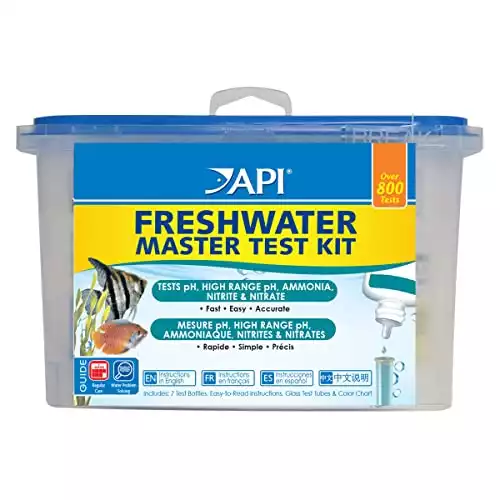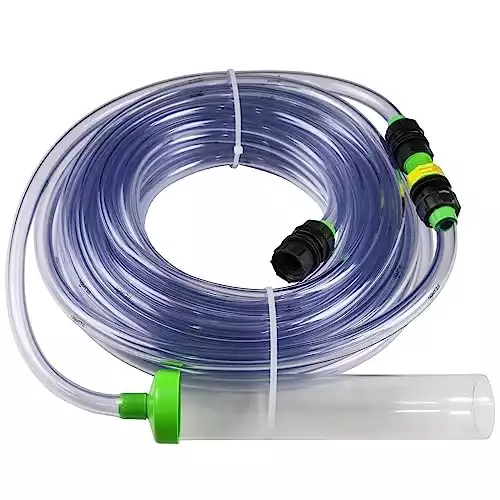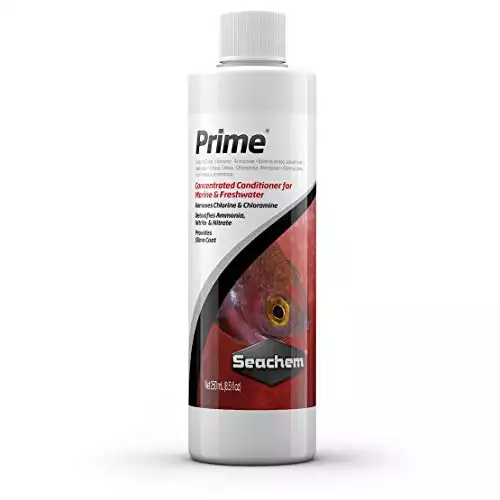
Have you ever seen a fish tank with a bathroom in it? Me neither. Sorry to gross you out, but your fish are swimming around in their own toilet.
I’m sure you wouldn’t want to swim around in poop water and neither do they!!
How Often Do You Need To Clean A Fish Tank?
Well, it depends…there are many variables to take into account and every fish tank is different. Unfortunately, there’s not a ‘one size fits all’ approach, so you’ll need to find the correct solution for your tank.
The number of nitrates a fish tank produces can vary hugely from tank to tank. Fish stocking levels, the type of fish you keep, how good your filtration is, and whether you have live plants or not can make a huge difference.
The main purpose of cleaning fish tanks (other than to keep them looking amazing!) is to keep the nitrates at a safe level for your fish. If the nitrate levels get too high, this is dangerous for your fish and will eventually lead to them becoming ill or dying.
So let’s figure out how often you need to clean your aquarium / do a partial water change. I’m assuming your tank is fully cycled and that you have added your fish already…
First things first, you’ll need a water testing kit.
The API Freshwater Master Test Kit has been my go-to kit for years.
The API freshwater test kit offers outstanding value (over 800 tests!) and is very accurate, if you're serious about fishkeeping this is the best test kit to buy and the only one I use.
- Includes 7 bottles of testing solutions, 1 color card, and 4 tubes with caps.
- Performs over 800 tests.
- Accurately monitors the 5 most vital water parameter levels in freshwater aquariums: pH, high range pH, ammonia, nitrite, and nitrate.
- Helps monitor water quality and prevent invisible water problems that can be harmful to fish and cause fish loss.
- More time consuming than test strips
You will need to test your water every day and keep a log of the results. Once your nitrates exceed 20 ppm, perform a 25% water change.
Keep testing your water daily and log the results until the nitrates are back up to 20 ppm. You’ll soon work out how often you’re going to have to clean your tank with your current bioload.
E.G. If after your water change, it takes 1 week for your nitrates to get back up to 20ppm, you know you have to clean your tank and perform a 25% water change once per week. If it takes 2 weeks for them to get back up to 20ppm, you guessed it, you will need to clean your tank every 2 weeks.
I try not to let my nitrates get above 20 ppm (parts per million). If you have invertebrates or amphibians, this number will need to be lower.
Some fish can tolerate higher nitrates, but general consensus is that once nitrates reach 40 ppm, you need to get them down quickly as your fish can start to suffer when they are at this level.
Ideally, you don’t want to change more than 30% of the water in your aquarium at any one time, as this can cause your water parameters to vary too much, which will stress your fish. I stick to 15%-25% water changes.
Do I Take The Fish Out To Clean The Tank?
No, you don’t need to remove the fish. I prefer to leave the fish in as it’s far less stressful for them and also avoids accidentally injuring them.
As you’re only changing around 25% of the water there’s still plenty of room left for them to swim in.
What Equipment Do You Need To Clean A Fish Tank?
An essential tool that you will need is a gravel vacuum siphon. This is used to clean your substrate and drain your dirty tank water.
I use the Python No Spill Clean and Fill Aquarium Maintenance System.
Using the Python system takes the hassle out of cleaning your aquarium and performing water changes.
No cumbersome buckets full of fish poop water will need to be carried through your home again!
It's available in 4 different lengths from 25 feet - 100 feet.
It can take a little time to get the hang of using it correctly to begin with, but after a few tries you'll wonder how you ever managed without it.
It comes in 4 different lengths and allows you to empty the dirty water directly down your sink or toilet, onto your lawn or plants, or into an outside drain.
This piece of kit has been a game-changer for me as it makes the whole process much easier and less messy. It saves you from having to carry heavy buckets of dirty water around the house and eliminates spillages. I appreciate this kit may not be for everybody as it’s not the cheapest option, but treat yourself if you can!
Alternatively, you’ll need 2 large buckets. 1 for the dirty water and 1 for the clean water you will be adding to your aquarium. Ideally, these should be able to hold more of your aquarium water than you’re changing to cut down on spillages.
You will also need the following items to properly clean your fish tank:

- Algae scraper and/or pads – buy aquarium-specific pads, so there are no harmful chemicals
- Aquarium glass & acrylic cleaner
- Aquarium water test kit
- Dechlorinator water treatment
- Filter media & brush
- Old bath towels to mop up any spillages
- Paper towels or glass cleaning cloth
- Razorblade – Use a plastic bladed scraper if you have an acrylic aquarium
- Toothbrush
Preparations
Like any job, there are a few preparations to make before starting.
Place the old bath towels on the floor around your aquarium just in case of any spillages. I can say from past experience, that my other half doesn’t appreciate dirty fish tank water being slopped onto our carpets!!
Thoroughly wash your hands and forearms, you don’t want to be putting any unnecessary bacteria into the fish tank.
If you’re treating another aquarium for a disease such as ich, believe me, you do not want to cause an accidental outbreak of it in a 2nd aquarium.
Also, make sure any soap is properly rinsed off your skin as household soaps can be harmful to fish.
Turn off any equipment such as filters, heaters, and pumps. These are designed to operate with water in the tank and they may become damaged if they’re left running in dry air.
I also recommend unplugging and removing the tank lights as a safety precaution and to avoid damaging them.
How To Clean A Fish Tank Without Removing The Fish
Now your preparations are done, let’s get cleaning!
1. Clean The Inside Glass / Acrylic

Always start with the inside of the glass. Algae scrapers, algae pads, or razor blades are great tools for this. If you have an acrylic fish tank use a scraper with a plastic blade so you don’t damage the tank.
Any algae growing on your tank lid can easily be washed off in the kitchen sink, but don’t use any soaps.
Be careful not to get any substrate between the blade and glass/acrylic as it will cause scratches.
If you’re finding that you have too much algae building up, you could always look at adding some algae eaters or plants to your aquarium.
2. Clean Decorations, Rocks, & Plants

You don’t need to clean the decor every time. There are tons of beneficial bacteria that live on your decor, so you don’t want to scrub it all away.
Lightly scrub your decor items and artificial plants with a toothbrush if needed. It’s fine for them to remain in the aquarium while you do this.
Algae pads should make short work of any stubborn built-up algae that the toothbrush can’t shift.
If you have any live plants in your tank, now’s the time to prune them and remove any dead or damaged leaves.
3. Clean The Filter – If Needed

You may not need to clean the filter every time you clean your tank, it all depends on the bioload of your tank.
If the filter looks gunked up and the water flow appears reduced, or if you notice there are more fine particles floating around in your water, it probably needs a clean.
DO NOT rinse the filter media with faucet water.
Faucet water contains chlorine/chloramine that can kill the beneficial bacteria that you have been lovingly growing for months, potentially crashing your nitrogen cycle.
I use tank water for cleaning my filter media, and then use the dirty water that I’ve rinsed my filters in to fertilize my garden and house plants.
Add some tank water to a container, like a bucket or ziplock bag, then gently squeeze the sponge filter or media to release any buildup. Repeat this process a few times until the water runs clear.
When the filter media will no longer rinse clean or is falling apart, I recommend changing around 25% of it at any one time, this lets the beneficial bacteria populate the new filter media. You want to keep as much of the good bacteria alive as possible.
If you have a HOB (Hang On Back), be sure to clean the impeller (the part of the motor that spins and causes the suction) as debris can get stuck and stop it from working.
4. Vacuum The Substrate & Siphon The Water

Next up we’re on to cleaning all the detritus from the substrate and removing 25% of the tank water. Your aquarium siphon will perform both tasks in one go here.
Put the tube end of the siphon into your aquarium, and place the hose end either in your kitchen sink, out on the lawn, or in an empty bucket.
Keep an eye on the bucket as it’s easy to get carried away and have it overflow, no one wants poop water on the floor.
If you have any household or garden plants, the dirty fish tank water will make excellent fertilizer for them.
The flow of water through the siphon will stir up the substrate enough to pull all of the fish poop, leftover food, detritus, and algae out of it. Work in rows back and forth across the substrate, just like mowing your lawn.
If you happen to suck up one of your fish into the siphon tube, just crimp the hose to stop the flow of water. Once the fish is free un-crimp the hose to restart the flow of water again.
Continue siphoning the substrate until you’ve removed 25% of the aquarium’s water.
5. Refill The Tank

I recommend you test the water before adding it to your aquarium for the first time, especially if you use well water as this can be high in nitrates.
Before refilling your aquarium, check the tap water is at the same temperature as the water in your tank. Make sure to add the water dechlorination treatment into the aquarium as the water is refilling.
Refilling your tank is where things can get messy real fast. If you’re using the Python No Spill Clean and Fill Kit, this won’t be an issue as you refill your aquarium direct from the faucet.
If you’re using the 2 bucket method, fill the clean bucket with the same amount of water that you have just removed, then add the dechlorination treatment following the dosage instructions on the label.
Once you’ve given it a few minutes for dechlorination treatment to work, very gently (so you don’t spook your fish and stir up the substrate) pour the treated water into the aquarium.
How Long Do I Let The Water Sit Before Putting Fish In?
Tap water contains chlorine and/or chloramine, which is toxic to fish. So you need to remove this.
The easiest option is to add a water conditioner to the tank or bucket when adding new tap water.
Seachem Prime is an essential item for ALL fishkeepers!
It removes chlorine and chloramine from tap water.
It detoxifies ammonia, nitrite & nitrate, making the aquarium water safe for your fish.
Directions: Add 5 ml per 50 gallons (200 liters) for regular detoxification.
Up to 5 times the dose (25 ml per 50 gallons) can be used in an emergency if ammonia or nitrites exceed 2 ppm.
- Easy to use
- Removes chlorine & chloramine
- Detoxifies ammonia, nitrite & nitrate
- Doesn't expire (if stored correctly)
- Suitable for fresh & saltwater aquariums
- Strong sulphur smell
It will remove any chlorine or chloramine from the water, and will also detoxify any hard metals, so there is no need to let the water sit.
If you don’t want to add any water conditioner to your tank, you will need to let the new water sit for 24 hours so that the chlorine can evaporate. BUT, if you live in an area that treats your water with chloramine you will need to further treat the water as chloramine does not evaporate.
You can now switch the heater, filter, and pump back on. Make sure you add some water to your HOB filter before switching it on to avoid damaging it or causing an airlock in the system.
Your tank may look dirtier now than when you started, but it will settle down within an hour or so.
I don’t put my tank lights back on just yet. Not only so I don’t have to look at the mess until it settles, but it’s also easier on the fish while they’re adjusting to the change of water.
6. Clean The Outside Of The Tank

Now you’ve got the inside clean, you can give the outside a clean too.
Always use a dedicated aquarium acrylic/glass cleaner. Household and automotive glass cleaners usually contain ammonia, which is toxic to fish.
If you don’t have a glass cleaning cloth, paper towels will work just as well.
That’s it all done, it’s time to sit back, relax and admire your hard work!
Ongoing Maintenance & Tips
If you have a new tank, test the water weekly until it settles in. Once you have got your water parameters stable and consistent, test monthly to keep your eye on things and it will give you a heads up if something doesn’t look right and needs treating before it gets out of hand.
Spend time getting to know your fish and what is considered normal behavior for them. If you spot something out of the ordinary it could be an early warning sign that you may have a problem with your water.
If you add more fish to the tank, you will need to repeat the daily water testing and logging procedure. More fish = more poop, which means more nitrates, so you may need to do more frequent or larger water changes.
Inspect any equipment like thermometers, heaters, air pumps, and filters regularly to make sure they’re working properly.
If you are struggling with high nitrates, do daily water changes to bring the nitrates down, and consider adding some plants. Pothos is great at reducing nitrates and looks great too.
If you are still struggling with the water parameters, chances are your tank is overstocked, so you either need to upgrade your tank to a bigger size or reduce the number of fish.
Closing Thoughts On How To Clean A Fish Tank…
Cleaning a fish tank doesn’t have to be a huge chore if you keep on top of it.
Now you know the best way of cleaning a fish tank, your fish will be happy and healthy in their sparkling clean aquarium.
Check out the aquarium health section for more guides just like this one.



